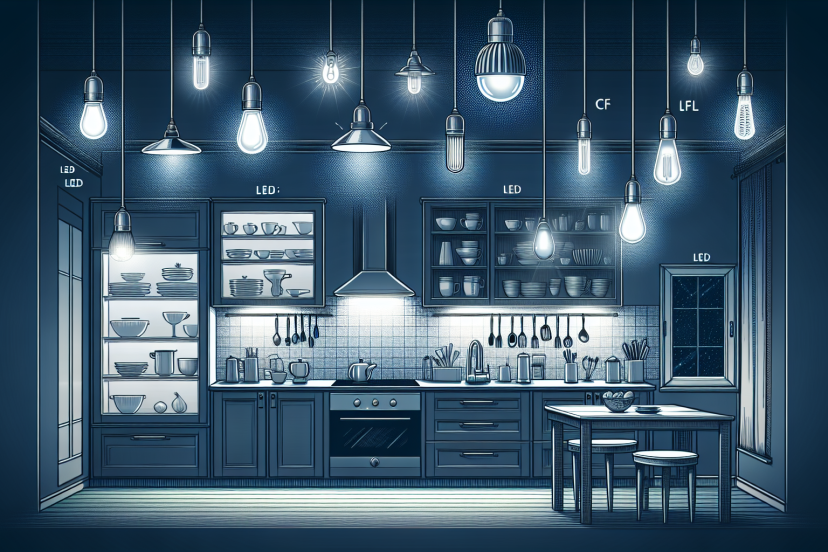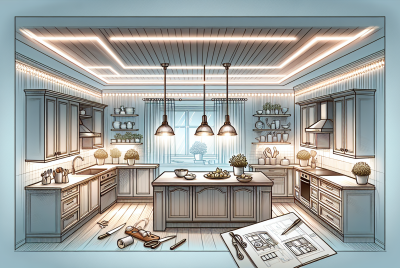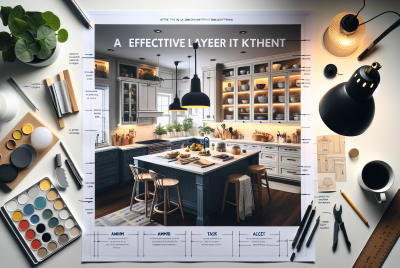Buyer’s Guide To Finding Energy-Efficient Kitchen Light Fixtures
Looking to brighten up your kitchen while minimizing your energy consumption? Look no further! In this article, we will be providing you with a comprehensive buyer’s guide to finding energy-efficient kitchen light fixtures. Whether you’re a budding home chef or simply want to create a welcoming ambiance in your kitchen, we’ve got you covered. From tips on choosing the right type of lighting to highlighting energy-efficient features, this guide will help you make an informed decision that not only enhances your kitchen aesthetic but also saves you money on your electricity bill. So, let’s shed some light on how to illuminate your kitchen in the most energy-efficient way possible!
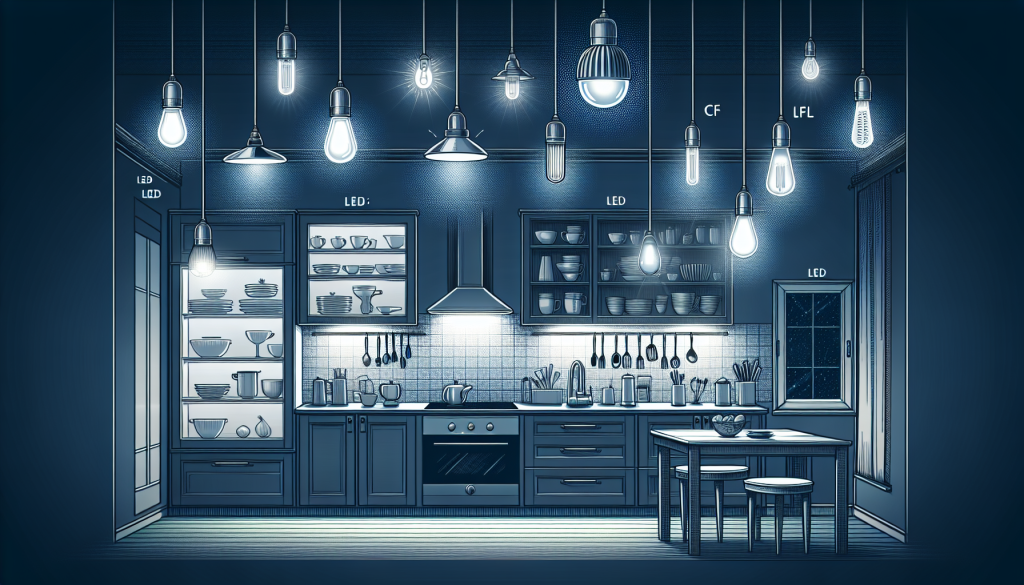
Determining Your Lighting Needs
Assessing your kitchen layout and size
When determining your lighting needs for your kitchen, it’s important to first assess the layout and size of your kitchen. Take note of the different areas within your kitchen that require lighting, such as the countertop, sink, and stove areas. Consider the size of your kitchen and the amount of light needed to adequately illuminate each section. This will help you determine the number and type of light fixtures needed for each area.
Identifying the tasks you perform in the kitchen
Next, identify the tasks you typically perform in your kitchen. Do you do a lot of food preparation and cooking? Or do you mainly use your kitchen for dining and entertaining? Understanding the specific tasks you perform in the kitchen will help you determine the level of brightness needed for each area. For tasks such as chopping vegetables or reading recipes, you may need brighter task lighting, while a softer ambient lighting may be more suitable for dining and entertaining.
Considering existing lighting fixtures
Before making any decisions, take a look at the existing lighting fixtures in your kitchen. Assess the functionality and condition of these fixtures. Determine whether they can be incorporated into your new lighting design or if they need to be replaced. Consider any limitations or constraints that may affect your lighting choices, such as the location of electrical outlets or existing wiring. By considering your existing lighting fixtures, you can make more informed decisions about the type and placement of your new fixtures.
Understanding Energy Efficiency Ratings
Exploring different types of energy-efficient light bulbs
Energy-efficient light bulbs are not only better for the environment, but they can also help you save on energy costs. Explore different types of energy-efficient light bulbs, such as LED, CFL, halogen, and incandescent. Each type has its own advantages and disadvantages, so it’s important to understand the features and benefits of each before making a decision.
Understanding lumens and wattage
When shopping for energy-efficient light bulbs, it’s important to understand the terms “lumens” and “wattage.” Lumens measure the brightness of a bulb, while wattage measures the amount of energy a bulb consumes. Energy-efficient bulbs typically have fewer watts but produce the same or greater amount of lumens as traditional bulbs. By understanding lumens and wattage, you can choose bulbs that provide the desired brightness while still being energy efficient.
Learning about the ENERGY STAR label
The ENERGY STAR label is a useful tool for identifying energy-efficient light bulbs and fixtures. Products that bear the ENERGY STAR label meet strict energy efficiency guidelines set by the U.S. Environmental Protection Agency (EPA). Look for the ENERGY STAR label when shopping for kitchen light fixtures to ensure you are choosing energy-efficient options that will help you reduce energy consumption and save money on your utility bills.
Choosing the Right Fixture Type
Considering the different types of kitchen light fixtures
There are several types of light fixtures to consider for your kitchen. Some common options include wall-mounted fixtures, overhead fixtures, under-cabinet fixtures, and task lighting. Each type of fixture serves a different purpose and can enhance the overall lighting in your kitchen. Consider the specific needs of each area in your kitchen and choose the appropriate fixture type to provide the desired lighting effect.
Wall-mounted fixtures
Wall-mounted fixtures are a popular choice for kitchens as they provide general ambient lighting. They can be mounted on the walls or above cabinets, and they come in a variety of styles and designs to complement your kitchen decor. Wall-mounted fixtures are a great option for evenly distributing light throughout the kitchen and creating a warm and inviting atmosphere.
Overhead fixtures
Overhead fixtures, such as recessed lighting or pendant lights, are another common choice for kitchen lighting. These fixtures are typically installed in the ceiling and provide focused task lighting. Pendant lights can be hung above a kitchen island or dining area to create a visually appealing focal point. Recessed lighting is a great option for providing overall illumination in the kitchen and can be adjusted to direct light where it is needed most.
Under-cabinet fixtures
Under-cabinet lighting is ideal for illuminating the countertop area and providing task lighting for food preparation. These fixtures are installed underneath the cabinets and can be either hard-wired or plugged into an electrical outlet. Under-cabinet lights come in various styles, such as strip lights or puck lights, and can be dimmable to adjust the brightness according to your needs.
Task lighting
Task lighting is essential for areas where specific tasks are performed, such as the stove or sink area. Task lights should be bright enough to provide ample visibility for these tasks. Consider installing adjustable fixtures, such as track lighting or adjustable pendant lights, to ensure the light can be directed precisely where it is needed.
Selecting the Appropriate Light Bulb
Comparing different types of bulbs
When selecting the appropriate light bulb for your kitchen, it’s important to compare the different types available. Incandescent bulbs are the traditional option but are not as energy-efficient as newer alternatives. Halogen bulbs are more efficient than incandescent bulbs and provide a bright, white light. CFL bulbs are compact and energy-efficient, while LED bulbs offer long-lasting performance and significant energy savings.
Incandescent bulbs
Incandescent bulbs are the most common type of bulb found in traditional light fixtures. They produce warm, soft light but are not as energy-efficient as other options. Incandescent bulbs have a shorter lifespan and consume more energy, resulting in higher electricity bills. Consider upgrading to more energy-efficient options, such as CFL or LED bulbs, to reduce energy consumption and save money in the long run.
Halogen bulbs
Halogen bulbs are an improvement over incandescent bulbs in terms of energy efficiency. They produce a bright, white light that is similar to natural daylight. Halogen bulbs are also dimmable, making them a versatile option for different lighting needs. However, they have a shorter lifespan compared to CFL and LED bulbs and can get hot, so caution should be exercised when handling them.
CFL bulbs
Compact fluorescent lamps (CFL) are a popular choice for energy-efficient lighting. They use about 75% less energy than incandescent bulbs and last up to 10 times longer. CFL bulbs are available in a wide range of colors and can produce warm or cool light depending on your preference. They are an affordable option and are widely available in most stores.
LED bulbs
LED bulbs are the most energy-efficient option for kitchen lighting. They use up to 80% less energy than incandescent bulbs and have a much longer lifespan. LED bulbs are available in a variety of colors and can be dimmable, making them suitable for any lighting preference. While LED bulbs may have a higher upfront cost, the long-term energy savings and durability make them a worthwhile investment.
Color temperature and CRI
When choosing light bulbs for your kitchen, consider the color temperature and color rendering index (CRI). Color temperature refers to the perceived warmth or coolness of the light, with lower Kelvin values indicating warmer light and higher Kelvin values indicating cooler light. CRI measures the ability of a light source to accurately depict colors. For kitchen lighting, a color temperature of around 2700-3000K is recommended to create a warm and inviting atmosphere, while a CRI of 80 or above ensures that colors appear vibrant and true.
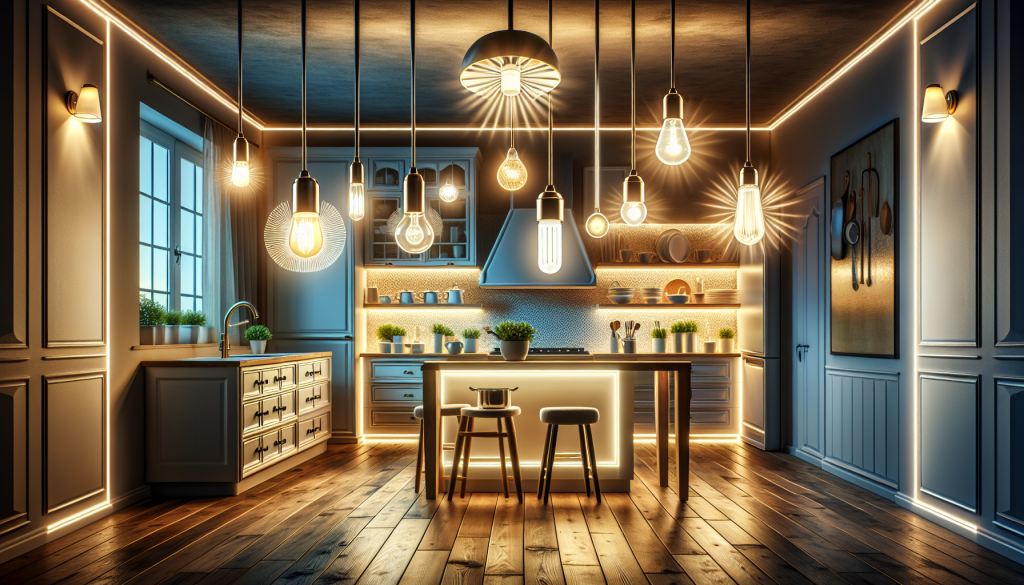
Looking for Energy-Efficient Features
Motion sensor technology
Consider incorporating motion sensor technology into your kitchen lighting design. Motion sensors automatically turn on the lights when someone enters the room and turn them off when there is no activity detected. This feature can help reduce energy waste by ensuring that lights are only turned on when needed and can also provide added convenience in a busy kitchen.
Dimmable options
Choosing dimmable light fixtures or light bulbs allows you to control the brightness of your kitchen lighting. Dimming the lights can create a more relaxed atmosphere for dining or entertaining, while also providing the option for brighter lighting when needed for tasks. Dimmable options can help save energy and extend the lifespan of your light bulbs.
Lighting controls and automation
Explore lighting controls and automation systems that can further enhance the energy efficiency of your kitchen lighting. These systems allow you to program and control your lights remotely, adjust brightness levels, and set schedules for automatic on/off functions. With lighting controls and automation, you can optimize energy usage and customize your kitchen lighting experience to fit your needs.
Considering Maintenance and Lifetime Costs
Evaluating the lifespan of different bulbs
When considering maintenance and lifetime costs, it’s important to evaluate the lifespan of different types of bulbs. Incandescent bulbs have the shortest lifespan, lasting about 1,000 hours. Halogen bulbs last slightly longer, typically around 2,000 to 4,000 hours. CFL bulbs have an average lifespan of 8,000 to 10,000 hours, while LED bulbs can last up to 50,000 hours or more. By choosing bulbs with longer lifespans, you can reduce the frequency of bulb replacements and save on maintenance costs.
Calculating the total cost of ownership
To determine the lifetime cost of your lighting fixtures, calculate the total cost of ownership. Consider the initial cost of the fixture and bulbs, as well as the cost of energy consumption and replacement bulbs over the expected lifespan. Energy-efficient options, such as LED bulbs, may have higher upfront costs but can provide significant savings over time due to their long lifespan and energy efficiency.
Replacing bulbs and fixtures
Regularly inspect and replace any bulbs or fixtures that are not functioning properly or have reached the end of their lifespan. Maintaining properly functioning light fixtures will ensure optimal lighting in your kitchen and maximize energy efficiency. When replacing bulbs, be sure to choose energy-efficient options that meet your lighting needs to continue saving on energy costs.
Researching Brands and Models
Exploring reputable brands
When it comes to kitchen lighting, it’s important to choose reputable brands known for their quality and reliability. Research and explore different brands that specialize in energy-efficient lighting. Look for brands that have positive customer reviews and offer warranties on their products. Reputable brands are more likely to provide energy-efficient options that meet your lighting needs and provide long-lasting performance.
Reading customer reviews
Reading customer reviews can provide valuable insights into the performance and reliability of different lighting fixtures. Look for reviews that specifically mention energy efficiency and durability. Positive customer reviews can help validate the claims made by the manufacturer and give you confidence in your purchase. Consider multiple sources and read reviews from verified buyers to get a well-rounded understanding of the product.
Comparing energy-saving features
When researching different brands and models, pay attention to the energy-saving features offered. Look for features such as low wattage consumption, high lumens output, and ENERGY STAR certification. Energy-saving features are indicators of a product’s energy efficiency and can help you make an informed decision on which lighting fixtures will provide the most energy savings for your kitchen.
Shopping within Your Budget
Setting a budget for your kitchen lighting
Before you start shopping for kitchen lighting fixtures, set a budget to guide your purchasing decisions. Consider how much you are willing to spend on the initial purchase as well as any ongoing maintenance costs. Setting a budget will help you narrow down your options and prevent overspending. Remember to consider long-term savings when evaluating the cost of energy-efficient options.
Comparing prices
Take the time to compare prices from different retailers to ensure you are getting the best deal. Consider visiting both physical stores and online retailers to compare prices for the same or similar products. Pay attention to any ongoing sales, promotions, or discounts that may be available. While price is an important factor, also consider the quality and energy-saving features of the lighting fixtures to make an informed decision.
Assessing long-term savings
When shopping for kitchen lighting fixtures, keep in mind the long-term savings that energy-efficient options can provide. While energy-efficient fixtures may have a higher upfront cost, they can result in significant savings on your energy bills over time. Consider the potential energy savings and lifespan of the fixtures to determine whether the upfront investment is worth the long-term benefits.
Installation Considerations
Determining if professional installation is necessary
When it comes to installing kitchen lighting fixtures, it’s important to determine if professional installation is necessary. Some fixtures may require electrical wiring or modifications that are best handled by a licensed electrician. If you are uncomfortable or unsure about performing electrical work, it is recommended to hire a professional to ensure safe and proper installation.
Assessing the difficulty level of installation
For simpler installations, such as replacing light bulbs or installing plug-in fixtures, you may be able to handle the installation yourself. However, it’s important to assess the difficulty level and complexity of the installation before attempting it. Read the manufacturer’s instructions carefully and gather the necessary tools and materials before starting the installation. If you are unsure or inexperienced, it is always best to seek professional assistance.
Checking for compatibility with existing wiring
Before purchasing any lighting fixtures, check for compatibility with your existing wiring. Ensure that the fixtures you choose are compatible with the voltage and wiring system in your home. If you are uncertain, consult a professional to help you determine the compatibility and make any necessary adjustments or upgrades to your electrical system.
Understanding Energy Efficiency Incentives
Researching available rebates and incentives
Many utility companies and government entities offer rebates and incentives for energy-efficient upgrades, including kitchen lighting fixtures. Research the available rebates and incentives in your area to see if you qualify for any programs. These programs can help offset the cost of purchasing energy-efficient lighting fixtures and provide additional savings.
Understanding tax credits
In addition to rebates and incentives, there may also be tax credits available for energy-efficient upgrades. Research the current federal and state tax credits for energy-efficient lighting fixtures to determine if you are eligible. Tax credits can provide a significant reduction in your overall cost and make it more affordable to invest in energy-efficient kitchen lighting.
Finding local utility programs
Local utility companies often offer energy efficiency programs that can help you save money on your energy bills. These programs may include free or discounted energy audits, appliance rebates, or incentives for energy-efficient upgrades. Contact your local utility provider to inquire about any programs that may be available for upgrading your kitchen lighting fixtures.
In conclusion, finding energy-efficient kitchen lighting fixtures involves assessing your kitchen layout and tasks, understanding energy efficiency ratings, choosing the right fixture type and light bulb, considering energy-efficient features, evaluating maintenance and lifetime costs, researching brands and models, shopping within your budget, considering installation considerations, and understanding energy efficiency incentives. By following this comprehensive buyer’s guide, you can make informed decisions that will not only enhance the lighting in your kitchen but also save you energy and money in the long run.

